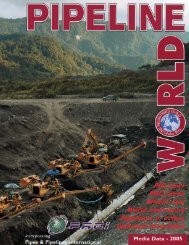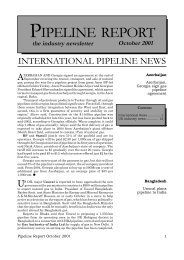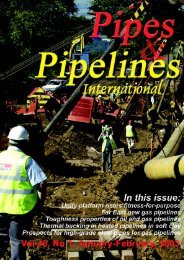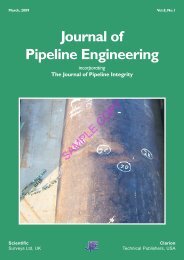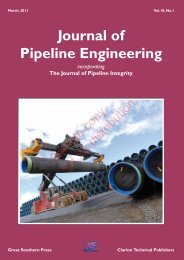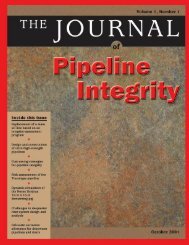JPE - Sept09 - cover2-4.pmd - Pipes & Pipelines International ...
JPE - Sept09 - cover2-4.pmd - Pipes & Pipelines International ...
JPE - Sept09 - cover2-4.pmd - Pipes & Pipelines International ...
Create successful ePaper yourself
Turn your PDF publications into a flip-book with our unique Google optimized e-Paper software.
176<br />
Background on case study<br />
The Camisea system consists of a buried natural gas (NG)<br />
pipeline and a buried natural gas liquid (NGL) pipeline.<br />
The NGL pipeline transports liquid condensates from<br />
Malvinas in the Peruvian Amazon to a fractionation plant<br />
near Pisco, on the coast of Peru south of Lima (see Fig.1).<br />
The pipeline starts in the jungle (“selva”) and climbs up the<br />
east slopes of the Andes Mountains (“sierra”) to a height of<br />
approximately 4,800m, from where it drops steeply towards<br />
the coastal (“costa”) city of Pisco. The NGL pipeline is<br />
approximately 561km long, and telescopes from a nominal<br />
pipe diameter of 14 to 10.75in. The wall thickness of the<br />
NGL pipeline ranges between 0.219 and 0.469in. The 734km<br />
long and larger-diameter NG pipeline shares the same<br />
right-of-way (RoW) along its initial 550km until it follows<br />
the Pacific coast towards Lima. Both pipelines are<br />
constructed of tubular high-strength steel (X70) in<br />
conformance with the American Petroleum Institute (API)<br />
5L standard, welded and inspected per API 1104, and<br />
The Journal of Pipeline Engineering<br />
Mountains, the Camisea transportation system, which is buried in a region where landslides and other<br />
geological hazards are common.<br />
In this paper an elastic plastic fracture mechanics analysis of a pipeline is presented that ruptured due to<br />
external soil loading, to evaluate possible loading conditions and correlate the observed crack propagation<br />
with possible external loading conditions. Next a fracture mechanics based performance criterion is derived<br />
for the most commonly used in-line inspection (ILI) methods, to detect these circumferential cracks; i.e.<br />
the magnetic flux leakage (MFL) tool.<br />
Fig.1. Alignment of the NGL and NG pipeline of the Camisea system in Peru [5].<br />
protected by a triple layer of polyethylene. All girth welds<br />
were x-rayed 24hrs after welding and evaluated per API<br />
1104 [5, 6].<br />
Since the Camisea Transportation System was brought<br />
into service in August, 2004, the NGL pipeline has<br />
experienced six spill incidents involving a release of NGL;<br />
however, no incident has been reported for the NG pipeline<br />
(see Fig.1). Three of these failures occurred at girth welds<br />
and were determined to result from soil loading due to<br />
ground movement [5]. Overall the Camisea pipeline system<br />
has experienced a spill incident rate of approximately 1.1<br />
spill incidents 2 per 1000 km year, which is slightly larger<br />
than the spill incident rate of contemporary South American<br />
pipelines through similar regions that were constructed<br />
with the newest geotechnical means. However, the spill<br />
incident rate of the Camisea system should improve because<br />
2 Using the combined length of the NG and NGL pipeline.<br />
Sample issue



